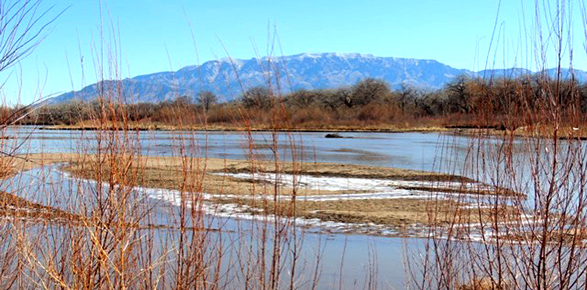
In 2002, the New Mexico Environment Department labeled the mid Rio Grande as an impaired river, i.e., the water quality did not meet the designated standards for a river. The major pollutants were identified as E.coli bacteria, oxygen depleting substances, polychlorinated bio-phenols (PCBs), and gross alpha radiation.
Federal and state agencies, county and local municipalities, and tribes began meeting. They developed the Watershed Restoration Action Strategy (WRAS) with two action strategies, one for Tijeras Creek in 2004 and one for the Albuquerque portion of the river in 2006. They have been working on these ever since as funds became available. There is also ongoing monitoring of the pollutants in ten-year cycles.
Fecal contamination occurs when the number of E.coli bacteria (used as the marker for all microbial contamination) passes a certain level. Along the Rio Grande, sources of this contamination include leaking septic tanks, farm animals, birds and an impressive 20% from dog poop.
Oxygen depleting substances disturb the needed balance in water to support life for microbes, fish, and plants. When too many nutrients such as nitrogen and phosphorus from our fertilizers get into the river, microbes increase, using up the oxygen in the water. When this happens it causes dead zones in which fish and other aquatic fauna and flora die.
PCBs were banned in the US in 1979, but these chemicals linger in high concentrations in water and sediments and continue to be highly toxic for humans, causing birth defects and neurologic diseases. Along the Rio Grande, PCB contamination is thought to have come from the industries manufacturing electrical components and oils.
Gross Alpha Radiation refers to large particles which are emitted from the decay of Uranium and Radium, most occurring naturally from soil and rocks. They do not travel far, but when they enter animal or human human bodies, they do damage.
So, what has happened since our river was labelled impaired?
The mitigation of fecal contamination was prioritized as the first goal by WRAS. This led to the familiar signs of “Scoop the Poop” and “There is no Poop Fairy” in 2014. This has been moderately successful in recent monitoring while testing results for the other pollutants has remained at consistent levels.
Decreasing oxygen depleting substances has been worked on by the Ciudad Soil and Water Conservation program. They have focused their efforts on two tributaries coming into the mid Rio Grande; Las Huertas Creek and the Tijeras Arroyo.
Funding has became available over time for other projects. Sandia Pueblo was able to work on restoration of their riparian environment. Sandoval County did some storm water projects. Attempts to decrease suspended sediment in Las Huertas Creek is being monitored, and the Tijeras Water Collaborative has a plan for public education for both erosion control and nutrient sources coming into the Tijeras Creek.
NMED monitoring of the mid Rio Grande is done over a two-year period with samples taken of water, sediment, and fish tissue, for example. Samples are taken in Spring, Fall, and Winter. The tests are expensive and the amount of surface water to be monitored by NMED statewide is great. Lack of funding drives the number of substances which can be monitored, the frequency of monitoring and mitigation projects. Currently, more radionucleotides are being monitored than previously, but PCBs are not considered a core pollutant at this time. Polyfluoroalkyl Substances (PFAS) are being monitored in our area as part of a pilot project NMED is conducting statewide.
The next two-year cycle of monitoring in the mid Rio Grande will be 2025 and 2026. The standards for calculations adjust for both drought and high water flow years, so comparisons over time are possible.
Our EPA office in Dallas is also involved in maintaining the quality of our water. They issue permits regulating what municipal water treatment plants and industries may discharge into the river. These permits provide real “teeth” as to what can go into the river with substantial fines for violations.
A more recent threat to the already impaired Rio Grande comes from a revision of the Clean Water Act, exempting from the Act’s protection any water which does not flow the entire year. Ninety percent of New Mexico’s rivers and streams flow intermittently because of dry seasons or drought years. This includes the Rio Grande, which periodically does not flow visibly in areas near Las Cruces but flows underground. This new rule has been nicknamed the Dirty Water Rule, and environmental advocates have filed a law suit in Federal Court challenging these re-definitions. The new administration however has started a review of this rule as part of the process to have the Clean Water Act rules reinstated as intended.

